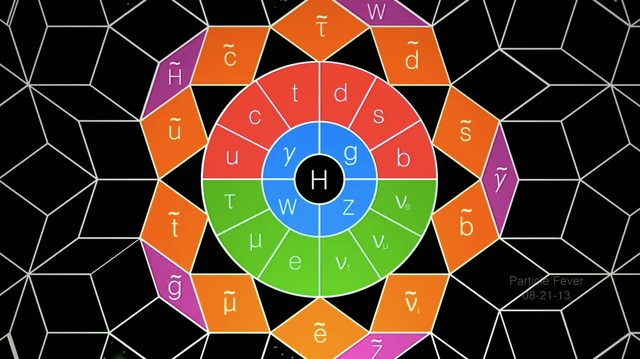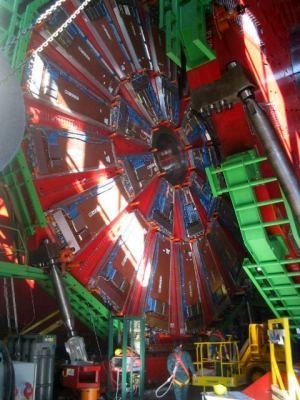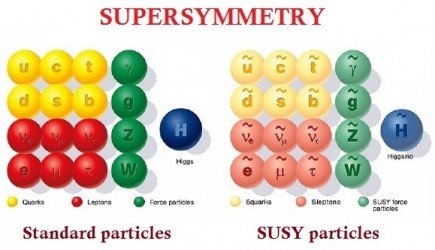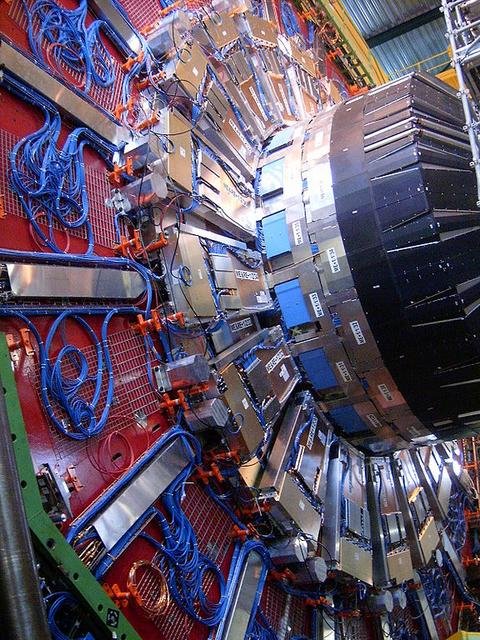Discussing my own research - hunting for flavorful new phenomena at the Large Hadron Collider
I discuss today my latest research article, which appeared on the online archives roughly three weeks ago. For those interested in reading the full thing, the paper can be downloaded from here.

[image credits: CERN]
In this article, collaborators and myself discuss the sensitivity of the Large Hadron Collider, the LHC running at CERN, to new phenomena messing up with flavors.
But what all of that mean explicitly?
What flavors are we talking about?
And why is this work of mine important?
PARTICLE PHYSICS STUDIES OF NEW PHENOMENA
Let me first try to sketch one of the main purposes, in my humble opinion, of all theoretical studies investigating new phenomena at the Large Hadron Collider. We have indeed thousands of them published every year, and there is a good reason behind this.
Of course, physicists want to know which models featuring new phenomena, coined new physics models, are still viable with respect to data. Moreover, we also want to know how to probe these models better, with the experiments we have at our disposal. This is the reason number one. But that is not the end of the story.
The other reason relies on the fact that we know for sure that the Standard Model of particle physics, despite working so well, is incomplete. Therefore, we must have some new phenomena somehow, stemming from a new theoretical framework extending the Standard Model.

[image credits: Freerk (CC BY-SA 3.0)]
The exact nature of the some and somehow of the previous sentence is the one-million-dollar question, together with the precise definition of the above-mentioned new framework.
To be able to answer this question, we, as physicists, need to make sure that all the possible corners where these some and somehow may lie are covered by the experimental searches.
This was the key point of my article: we picked an exemplary toy model representing large classes of theories. It turned out that the main handle on these theories at the LHC was not covered by the current searches. We hence demonstrated that the experimental search program in particle physics had to be extended.
We indeed cannot afford any loophole here
[ I have started with the TLDR part this time... ]
SUPERSYMMETRY IN A NUTSHELL
In my work, we focused on a class of supersymmetric models. Let us thus continue this post by defining supersymmetry.
In general, we have to distinct classes of particles in the universe: fermions and bosons. Fermions and bosons differ by their spin, that consists in their intrinsic angular momentum. This property is associated with a quantum number that can be a half-integer (fermion) or an integer (fermion) number. Ignoring any single detail, the important point is that fermions and bosons consequently possess totally different properties.
In the Standard Model, the matter sector (the most elementary constituents of matter) is made of fermions, whilst the interactions are mediated by bosons. And the Higgs boson… is a boson.

[image credits: everywhere on the web…]
Supersymmetry is one of the possible symmetries realized in nature and it maps bosons and fermions. Supersymmetry hence transforms a boson into a fermion, and vice versa.
In the simplest supersymmetric extension of the Standard Model, each Standard Model particle gets a partner. This is illustrated on the image on the left.
The advantages of such a framework is that several of the conceptual issues of the Standard Model are solved. For instance, supersymmetry features the unification of three fundamental interactions, makes the Higgs stable, predicts dark matter, etc.
FLAVORFUL SUPERSYMMETRY
If we analyze the picture in the previous section, we can observe six standard quarks: the @up-quark, @down-quark, @strange-quark, @charm-quark, @bottom-quark and @top-quark. Yes, all these Steem accounts exist…
The quarks are the tiniest bits making all atomic nuclei of the universe, as well as other unstable beasts. More information can be found in this post, so that I will omit any single detail again. Life is hard I know!

[image credits: Harp (CC BY-SA 3.0)]
In supersymmetry, all quarks get actually two partners named squarks. We have thus 12 of those squarks, and none of them is on Steem yet!
Supersymmetry being very popular, many studies have investigated how to discover squarks at colliders, relying on the fact that a given squark was the partner of the corresponding quark.
Consequently, a top squark can decay into a top quark (and dark matter), and a charm squark decays into a charm quark (and dark matter).
Since supersymmetric particles must be pair-produced, one could imagine the following two processes at the LHC:
- the production of a pair of top squarks decaying into two top quarks and invisible stuff;
- the production of a pair of charmed squarks decaying into two charm quarks and invisible stuff.
Those two squark production modes have been independently investigated deeply up to now, for null results unfortunately.
Intriguingly enough, the mixed case is possible. We could produce one top and one charm squark that then decay into a charm quark, a top quark and invisible stuff.
Amusingly speaking, this top-charm signature has been ignored by both ATLAS and CMS so far.
In my work, we have shown the potential of searching for it. Relying on the simulations of LHC collisions, we have demonstrated that it can help to cover a class of new physics model that could escape detection at the LHC otherwise.
TAKE-HOME MESSAGE
In this post, I have discussed a little bit what supersymmetry is and how it is searched for at the LHC. I have then move on with one of my recent research works, in which a new way to probe certain supersymmetric models at the LHC has been introduced. The idea was to close a loop hole in the experimental search program that was so far permitting certain classes of models to escape detection when relying on classical searches only.
One important strength of this article is that even if we focused on supersymmetry, the signature of the model can be common to many models. The results therefore hold in many different frameworks.
STEEMSTEM
SteemSTEM is a community-driven project that now runs on Steem for almost 2 years. We seek to build a community of science lovers and to make Steem a better place for Science Technology Engineering and Mathematics (STEM). In particular, we are now actively working in developing a science communication platform on Steem.
More information can be found on the @steemstem blog, on our discord server and in our last projet reports here and there.
Even though I don't understand half of this (obviously I have no physics background), this is very well explained and very informative.
What are your hopes that you or other physicists will be able to determine the "some" and "somehow" mentioned at the beginning of the article during our lifetime?
I think it is about how new physics models (like those incorporating supersymmetry) can explain some observations in the universe but are still not complete until they are verifiable through experiments. The Standard Model as it stands explains a lot (very precisely) but seems to be missing a piece. If we are to get a theory of everything, it needs to explain gravity, dark matter, electromagnetism, quantum mechanics, and everything else. Much like how Newton's theory of gravity works for many things, it still needed to be modified by relativity to explain things. The same need seems to be happening with the standard model of particle physics
I am feeling uncomfortable with a few of the terms you employed. More precisely, the fact a model is complete has nothing to do with the fact it is observed or not. Many complete models are still waiting for an experimental confirmation (and they are kind of incompatible with each other). The word 'complete' has here a very well-defined meaning (in the context of model building).
Now on a more personal basis, I believe we don't necessarily need to get to the theory of everything in one step (there re conceptual issues there, in particular in the way gravity could be incorporated). We could aim to something extending the Standard Model at high energy, and then something extending the extension at much larger energy (and so on).
That actually makes a lot of sense thanks!
My hopes? They are great! But one must bear in mind that many models may yield not any observable effects at the LHC or in dark matter direct detection experiments. The good news is that even if nothing is found, this will already clean up the plethora of available possibilities.
This being said. we have intriguing sign of new phenomena in the LHCb results. Maybe new physics is just there already :)
That is very clear thanks :-) I will keep following you and the topic very closely hoping new physics is around the corner!
You can count on me to spreading the news, if any :D
Y a t'il toujours des améliorations de prévu au niveau du LHC tant au niveau de sa puissance que des composants servant à la détection ou sommes nous déjà au maximum de ce que nous savons faire?
Est-ce que l'invisible stuff à des propriétés particulières? Les connaît-on?
Avec les quarks on est à 10-18 m du coup les squarks font la même taille? c'est actuellement le plus petit que l'on puisse attendre? (car encore un peu de marge avant la longueur de Planck)
Désolé on dirait un enfant de 6 ans qui pose 3000 questions pas toutes ordonnées mais comme lui qui s'emmerveille de découvrir le monde et tout ce qu'il voit moi je m'emmerveille dès que je vois ou lit un truc de science hahaha.
Merci pour ton commentaire en francais! Cela me motive a ecrire un peu plus dans la langue de moliere, ce que je vais essayer de faire plus souvent (vu que j'ecris peu en general, c'est pas gagne ;) ).
Le LHC va entrer a la fin de cette annee dans une periode d'upgrade (qui va durer 2 ans) en vue de son run 3. L'idee est d'augmenter la quantite de collisions par seconde. En consequence, les detecteurs seront aussi ameliores et repares (le grand taux de collision peut faire souffrir leur electronique).
Dans ce contexte-ci, ses proprietes sont connues vu que theoriquement, le modele de physique est tres bien defini. Par contre, il y a des parametres libres et en fonction de leur valeur, et bien on peut avoir de la matiere noire qui aura des proprietes legerements differentes (notamment en ce qui concerne ses interactions avec la matiere usuelle).
Attention ici. Parler de taille de quark est un abus de langage, car on a en fait une particule ponctuelle qui a une densite de presence ici ou la. A partir de cette densite de presence, on peut calculer, "mecaniquement quantique", une sorte de rayon moyen (a partir duquel on deduit la "taille des quarks").
De facon similaire, les squarks sont des particules ponctelles. Par contre, etant plus massif, son "rayon" sera plus petit.
N'hesite pas! J'adore ca! :)
Merci pour toutes ces précisions surtout que je n'avais pas envisagé le phénomène d'usure des détecteurs du aux collisions.
Comme les électrons et photons du coup, après vraiment pas évident si on est pas mathématicien de s'en faire une représentation sans faire appel à des éléments qui nous sont familiers et considérons comme concret. Mais comme ma question le prouve il en résulte une déformation de la réalité en amalgamant dans cet exemple taille et densité de présence.
Oui, mais c'est normal. La mecanique quantique n'a rien de facile du tout, notamment vu qu'elle est tres contre-intuitive :)
Would confirmation of supersymmetry lead us away from a theory of a multiverse like Everett's many worlds?
Also, perhaps a bit random and in a different field, but have you heard of the research on the distribution of prime numbers and x-ray diffraction from quasi-crystals? I thought it was interesting to see how seemingly different topics (materials science and number theory) could be related.
No. This will not help us to understand the foundation of quantum mechanics, but more how the universe works in terms of fundamental particles and symmetries.
Again a no. Sorry. This is a bit far from my field and you probably need another physicist here (physics is a vast field, ranging from quantum gravity to biophysics with everything you may think of in the middle).
lemouth just said BIOPHYSICS !!! I am excited!!!! Thanks gina!
Yes I did. There is 'physics' in 'biophysics' (and bio too) :D
I've downloaded your research material from the link you provided. I hope I'll be able to finish reading it soon. That 10page doc looks like a 500page doc, lol
PS: you created steemit account for all the six standard quarks, lol. I wonder what would be posted on these accounts
Probably interactions with gluons
I don't know yet. They will probably stay non-posting accounts for a while, I guess. I have no idea. @up-quark is the only one used so far (see my other answer in this thread).
Thanks for the interests in my work :)
Good luck with reading it. IT may sound really complicated for a non-particle-physicist. Please let me know if you have any question.
For the moment, @up-quark is used for a French-speaking community project (called fr-stars). The other ones are sleeping :)
Scientists are not boring people. This is contrary to popular beliefs, my proof? Check out the names of all the particles. Ain't they sweet? It is pretty exciting to be part of such a huge project. Nothing beats waking up to go to work with new discovery in the offing, sure beats the monotonous 9-5 jobs :)
I in contrast think that sometimes, we are missing imagination for finding good names. I am personally very bad in acronyms (I had once a project called BATS @ LHC) :)
Thank goodness the ATS was there, imagine telling selling your project is called BS :)
It was a typo... There is no S... it must be read "BATS" :D
I bet fans of Batman may see something awesome about it :)
Just bats... no man as the LHC is too narrow for a man :D
Greetings! Excellent information.
As I know, supersymmetry has not produced satisfactory results in recent attempts, even with considerably high energies.
Hopefully with small modifications we will answer: what is it, and what is behind the giant and frustrating dark matter?
It is funny to see how behind a theory that many consider to be wrong or useless, the bases of a whole new science can be formed (for example, the electrolytic theory of Arrhenius)
Great work, Regards!!
Thanks for the comment!
We indeed didn't find it, and it may or may not be there. However, even if nature is supersymmetric, there is no guarantee that supersymmetry will be found at current experiments. However, it is important to search for it (as well as for any other potential new physics theory), just to be sure we don't miss it.
We will definitely learn a lot about that in the next decade. What we will learn could be either positive, or negative, but we will learn anyways.
The theory is correct. However, the question is instead: is the theory realized in nature? And this, we can't answer yet (actually, there is always a mean to push supersymmetry to slightly higher scales explaining why we don't detect it. But this is a bit boring :)
I may be reading too much between the lines, but are you saying God is a bozo?
What about the ugly ones who are not models and do not have super-symmetrical figures, do they get left alone? Is it possible to get married if you are ugly but you possess a lot of charm-quark power, or maybe you are a top-quark CEO?
Oh come on, that's so unfair!
That's how Darth Vader was made. I think.
😄
Joking aside, congrats on your new research paper! 👍
Let me over-troll the jokes! Please!
No, I was talking about dogs, not gods :)
Depends whether we consider the left-handed or right-handed guys. One hence has a left scharm and a right scharm, as well as a left stop and a right stop. STOP here! (PS: the names are real supersymmetric particle names).
For the partner thing, don't worry, the price to pay is that the partners are unstable... Who wants that? Well, the Higgs probably :)
Thanks! We just got the referee report: one figure to improve and nothing else. Basically accepted :)
I like it when scientists try to prove the existence of invisible particles (DM) by colliding hypothetical particles (squarks) 😂
It's like solving a single equation with 3 unknowns! 😀
Thanks for another good post!
We are not really colliding squarks. We re producing squarks from proton collisions. The point is that the model contains a dark matter candidate, so that any new particle must decay into dark matter eventually. So whatever we produce, dark matter will be involved ;)
Ok but your are colliding protons to produce hypothetical particles (squarks) which decays into known particles (quarks) and other hypothetical particles (DM). 😋
Yep, as predicted by the full model that contains several dozens of new particles. The heavier ones decaying into the lighter ones decaying themselves into even lighter ones until the lightest: the dark matter candidate.
Wow, it is exciting stuff that you work upon. It is great to read about it, as I am a lapsed student of physics, but I do enjoy reading about the work and papers that you guys publish!
Why is the mixed mode of production not included in the data searching? Is it a limitation of computing power? Or is it something else?
The reason is that it is not there in the minimal model, and most searches are based on the minimal model. Now that we have pointed out its importance, we hope the experimental collaborations will start looking for it (at least one of the collaborations will do it :) ).
Thanks, I guess it makes sense to search using the minimal model first, then expanding if you don't find anything.
You are welcome.
It is important to make sure all options are covered. We have no idea about the surprizes nature has prepared for us. It is thus better to try to find them out in all possible ways.